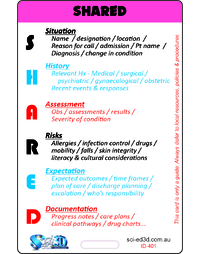Adverse Drug Reactions - A Case Study

After handover, you go and see him and immediately note that he isn’t well. He’s still complaining of pruritus, but now, his face, torso, and whole upper body are flushed and erythematous. He has a headache and his skin ‘feels like its burning’. You do a full set of obs. He’s a little bit hypotensive, but he’s afebrile, not tachycardic and all other parameters are within normal limits. Fortunately, he was not experiencing any signs of angioedema either. Whilst gathering the information ready to report your findings to the medical officer, you remember that an idiopathic infusion reaction to vancomycin can cause symptoms like this. It is often rate-related, so had his dose been given too quickly? You note that he’d not even had today’s dose of vancomycin yet.
Once Bob was reviewed by his treating team’s registrar, he was diagnosed with Red Man Syndrome (RMS) which was exacerbated by the antihistamine doses. Over the next few days/weeks, the erythroderma caused by RMS will most likely cause him to shed many layers of his thickening skin in sheets or flakes, such that his clothes, bed sheets, and surrounding area will look like a 300 person delegation of severe dandruff sufferers met around Bob’s bed for a month
Sure, most nurses know that penicillin allergies are relatively common, but, out of the reported 36,701 adverse drug reactions recorded in Australian public hospitals in 2017-2018, there were only 79 related to penicillins; 43 to cephalosporins; 26 to tetracyclines; and 8 to macrolides. Vancomycin-related events were coded less accurately, but appear to be 12 in 2017-18. Red man syndrome coding is not specific, so it is not clear how many people experienced it in Australia in 2017-18; however, literature suggests it occurs in between three and fifty percent of people receiving vancomycin. Therefore, it is something about which we probably should be aware.
Nurses commonly know that vancomycin is ototoxic and nephrotoxic, but do / can we know all important Adverse Drug Reactions? Do we spend those extra few minutes researching potential adverse events in MIMs before we give the drug, or do we just rely on past experiences to inform our clinical knowledge?
Have you heard of Red Man Syndrome? Did you know that is also associated with several drugs and other antibiotics such as cefepime, ciprofloxacin, rifampicin and teicoplanin? Red Man Syndrome can occur with any drug which stimulates histamine release, and therefore, drugs such as opiates and muscle relaxants can cause or exacerbate its development. RMS is mast cell mediated but it is not a true allergic reaction as it does not demonstrate the typical IgE-mediated immunologic mechanisms.
Often, RMS occurs within 10 minutes of the dose (especially at infusion rates exceeding recommendations); however, it may also present as a delayed reaction instead. Although RMS is not generally life-threatening, a severe reaction can result in chest pain, dyspnoea, hypotension, tachycardia and angioedema. As such, adverse events may exacerbate other chronic medical conditions.
It is generally managed by ceasing the vancomycin (or causative agent), and symptom relief with antihistamines, steroids, and fluids to support blood pressure as necessary. H2 antagonists such as ranitidine and cimetidine may also help reduce the histamine release.
In Bob’s situation, the antihistamine potentially exacerbated his reaction. Although counter intuitive and the mechanism is not clear, early research suggests that in some people (potentially related to genetic factors), antihistamine may increase the risk of experiencing RMS.
There are many adverse drug reactions causing acute dermatological effects from as simple as a transient urticaria (hives) through to serious events such as anaphylaxis and DRESS (drug rash with eosinophilia and systemic symptoms) which is characterized by a severe maculopapular eruption with fever and lymphadenopathy. DRESS can involve many organs and cause a chemical hepatitis which may be fatal. There is also Warfarin-induced Skin Necrosis, Drug-induced Vasculitis, Stevens-Johnson Syndrome (SJS) and Toxic Epidermal Necrolysis (TEN) to name a few more.
So, how are we to remember all these risks, outcomes and methods to manage these drug-induced dermatological events? The answer is, we don’t need to remember, we just need to consult appropriate literature such as drug inserts, MIMS, and other appropriate drug resources.
Majella Hales
References:
Arroyo-Mercado, F., Khudyakov, A., Chawla, G., Cantres-Fonseca, O., & McFarlane, I. (2019). “Red Man Syndrome with Oral Vancomycin: A Case Report.” American Journal of Medical Case Reports, 7(1), 16-17. doi: 10.12691/ajmcr-7-1-5.
Australian Institute of Health and Welfare (2019). Principal Diagnosis data cubes: Separation statistics by principal diagnosis (ICD-10-AM 10th edition), Australia, 2017-18. Retrieved from https://www.aihw.gov.au/reports/hospitals/principal-diagnosis-data-cubes/contents/data-cubes
Clinnard, V., & Smith, J. (2012). Drug-induced Skin Disorders. Medscape – US Pharmacist. Retrieved from https://www.medscape.com/viewarticle/763495_2
Martel, T., Jamil, R., & King K. (2019). Red Man Syndrome. StatPearls Publishing. Retrieved from: https://www.ncbi.nlm.nih.gov/books/NBK482506/
Weller, P. (2019). Vancomycin hypersensitivity. UpToDate. Retrieved from www.uptodate.com
So youÕve been caring for Bob, who has cellulitis and an MRSA positive wound infection on the lateral surface of his right lower leg. He has been receiving IV vancomycin for the last 3 days. Overnight he complained of pruritus, so the ward-call resident ordered him a stat dose of promethazine and had also written him a PRN order as well. By the time you started your shift, Bob had received 2 doses of the antihistamine.




